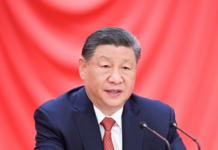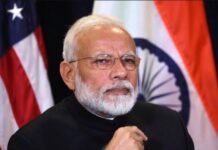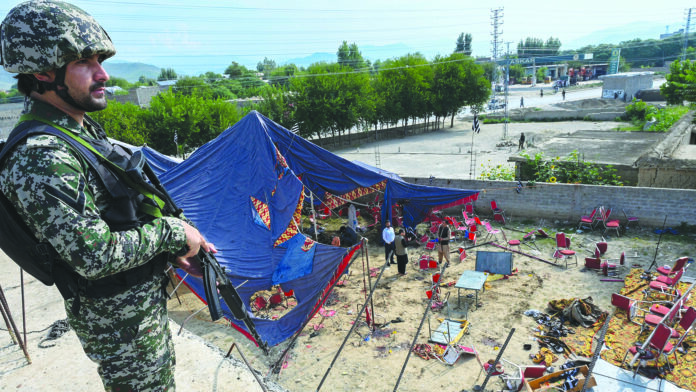The US and international troops’ withdrawal from Afghanistan has left the region in chaos. Multiple radical Islamist militant groups found the opportunity to reorganize and resurge, threatening peace in the region.
The most prominent and brutal organization in the central and South Asian region, ISKP (Islamic State Province Khorasan), was encouraged, which had carried out many deadliest attacks in Pakistan and Afghanistan. Islamic State Of Khorasan Province first came into existence at the end of 2014 when pro-IS slogan ‘Daesh Zindabad’ (Long Live Daesh) was found written on the outer wall of Kabul University. Later it led to the declaration of the expansion of Islamic State into Afghanistan and Pakistan, named Khorasan Province by its spokesperson Abu Muhammad Al-Adnani. The exact number of the fighters was elusive but the number estimated by a former general of US and NATO troops to Afghanistan at between 1000 to 1500, and most of its members joined from the Pakistani Taliban (TTP), who were forced out by the military operation Zarb-E-Azab in the ex-FATA region, and its initial recruitments were from the Pak-Afghan border. In 2021, the United Nations estimated its numbers to be from 1500 to 2000, centring on the Kunar and Nangarhar provinces in Afghanistan.
ISKP is a wilaya, meaning a province of the Islamic state, aiming to broaden the ideology of Islamic States, and Daesh aims to establish Caliphate system under its strict version of Islamic Jurisprudence and their motto “Baqiya Wa Tamaddad” urges other Muslims to pledge their alliance with Caliphate. Islamic State has issued “Aqidah wa Manhaj al-Dawlah al Islamiah fi al-Takfir” (The Creed and Methodology of Takfir), stating that one who reject the caliphate will be labelled a infidel (kafir) and executed. On the basis of this concept, their actions emerged as more violent and spread across the region.
In late 2014 and 2015, intense clashes occurred between Taliban and ISKP commanders over territory and resources in regions such as Kunar, Jowzjan, Farah, Sare Pul, Nagrahar, Helmand and Ghazni. In these clashes several Taliban commanders were targeted, and by mid-2015, ISKP fighters were able to capture eight districts in Nangarhar province. Since 2015, the group has become more frequent in its operations and deadly. In 2017, ISKP was alone responsible for 22 percent of the civilian deaths, killing more than 2000. From 2014 to 2019, the strategy of the organization was to capture the territory and consolidate it, but after the intense pressure and attacks from US/Afghan forces led to loss in the territories of ISKP, it consequently changed its strategy to urban warfare.
Still, ISKP continues to operate in the region, faces targets from all the three sides. In August 2020, it intensified its urban warfare strategy, exemplified in the complex suicide attacks on Nangrahar central prison in Jalalabad, resulting in the release of about 1000 prisoners and approximately 280 ISKP inmates.
In Pakistan, the Islamic State’s network is mainly controlled by two factions. One comprises the former leadership of TTP (Tehreek-e-Taliban Pakistan), mostly from the northwestern Khyber Pakhtunkhwa province. The second faction consists of anti-Shia sectarian groups operating in the southern Balochistan. Within Pakistan, IS engages in small arms and RPG attacks against relatively small groups accused of association with entities that oppose it, including police officials, intelligence, religious and ethnic minorities and political figures. IS prioritizes suicide attacks for a large-scale destruction, such as attack on Shia mosque in Peshawar and a suicide attack on political rally of JUI(F) in Bajaur district, which resulted in the deaths of 54 people.
US withdrawal from Afghanistan facilitated the rise to power of the Afghan Taliban and served as catalyst for religious militant groups such as TTP and ISKP in the region.
The last phase of a group’s demise is when it stops its violent acts and campaigns as a terrorist organization. This could happen when a group’s leader is captured or killed. Although ISKP has lost many leaders and hundreds of its fighters, it still remains active across the region after the withdrawal of US and NATO forces from Afghanistan. Furthermore, it is recruiting members from all nations and spreading its ideology.
US withdrawal from Afghanistan facilitated the rise to power of the Afghan Taliban and served as catalyst for religious militant groups such as TTP and ISKP in the region. These groups espouse anti-state agendas based on their supra-state ideologies. In Afghanistan, ISKP has established a stronghold in the Nazian, Achin, Kot, Deh Bela, and Spin Ghar districts of Nangarhar and is working to establish an ‘operational Caliphate,’ which could have implications for neighbouring border regions in Pakistan, including Bajaur, Dir, Chitral and Khyber Agency. The restructuring of religious militant groups in Pakistan and Afghanistan has complex implications, as both countries are economically crippled and politically unstable. Both states must address socio-economic disparities, foster tolerance and unity, and provide access to education, healthcare and employment opportunities to all their citizens.























